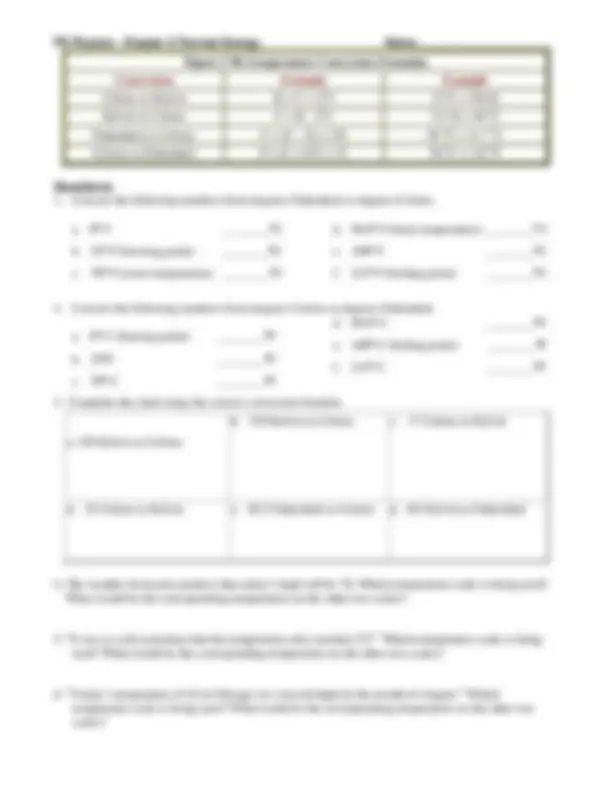



Study with the several resources on Docsity

Earn points by helping other students or get them with a premium plan


Prepare for your exams
Study with the several resources on Docsity

Earn points to download
Earn points by helping other students or get them with a premium plan
Community
Ask the community for help and clear up your study doubts
Discover the best universities in your country according to Docsity users
Free resources
Download our free guides on studying techniques, anxiety management strategies, and thesis advice from Docsity tutors
1. Convert the following numbers from degrees Fahrenheit to degrees Celsius. 2. Convert the following numbers from degrees Celsius to degrees Fahrenheit.
Typology: Lecture notes
1 / 2

This page cannot be seen from the preview
Don't miss anything!


PS Physics: Chapter 6 Thermal Energy Name:______________________
In your everyday life and in your study of Chemistry, you are likely to encounter three different temperature scales. When you watch the weather report on the news, they will report the temperature on one scale, yet you measure temperature in the laboratory on a different scale. Many Chemistry equations must be done using yet another temperature scale. Clearly, you can see the importance of the use of units when reporting temperature. You can also see the need, for a student of Science, to be able to convert temperatures from one scale to another. This page is designed to help you do just that.
The Fahrenheit Scale - The Fahrenheit scale is the scale that is used when they report the weather on the news each night. It is probably the temperature scale that you are most familiar with, if you live in the United States. The thermometers that you have in your house, for uses such as; swimming pools, cooking, bath tubs, or reading body temperature, are all likely to be in Fahrenheit. In Canada and most other countries, the news will report the temperature on the Celsius scale.
The Celsius Scale - The Celsius scale, is commonly used for scientific work. The thermometers that we use in our laboratory are marked with the Celsius scale. The Celsius scale is also called the Centigrade scale because it was designed in such a way that there are 100 units or degrees between the freezing point and boiling point of water. One of the limitations of the Celsius scale is that negative temperatures are very common. Since we know that temperature is a measure of the kinetic energy of molecules, this would almost suggest that it is possible to have less than zero energy. This is why the Kelvin scale was necessary.
The Kelvin Scale - The International System of Measurements (SI) uses the Kelvin scale for measuring temperature. This scale makes more sense in light of the way that temperature is defined. The Kelvin scale is based on the concept of absolute zero , the theoretical temperature at which molecules would have zero kinetic energy. Absolute zero, which is about -273.15 oC, is set at zero on the Kelvin scale. This means that there is no temperature lower than zero Kelvin, so there are no negative numbers on the Kelvin scale. For certain calculations, like the gas laws, which you will be learning soon, the Kelvin scale must be used.
Figure 2-9a Comparison of Temperature Scales Set Points Fahrenheit Celsius Kelvin water boils 212 100 373 body temperature 98.6 37 310 water freezes 32 0 273 absolute zero -460 -273 0
There will be times when you need to be able to convert a temperature from one scale to another. In real life, you might be in a country where temperature is reported in Celsius and you will want to convert that into Fahrenheit, in order to figure out if you need to wear a sweater. In your laboratory work, you may need to change from Celsius to Kelvin in order to calculate the volume that a gas might occupy at standard temperature and pressure. The table below will show you the formulas that you can use to change from one scale to another.
PS Physics: Chapter 6 Thermal Energy Name:______________________
Figure 2-9b Temperature Conversion Formulas Conversion Formula Example Celsius to Kelvin K = C + 273 21 oC = 294 K Kelvin to Celsius C = K - 273 313 K = 40 oC Fahrenheit to Celsius C = (F - 32) x 5/9 89 oF = 31.7 oC Celsius to Fahrenheit F = (C x 9/5) + 32 50 oC = 122 oF
Questions
a. 0 F ________C
b. 32 F (freezing point) ________C
c. 70 F (room temperature) ________C
d. 98.6 F (body temperature) ________ C
e. 100 F ________C
f. 212 F (boiling point) ________C
a. 0 C (freezing point) ________F
b. 32 C ________F
c. 70 C ________F
d. 98.6 C ________F
e. 100 C (boiling point) ________F
f. 212 C ________F
a. 250 Kelvin to Celsius
b. 339 Kelvin to Celsius c. 17 Celsius to Kelvin
d. 55 Celsius to Kelvin e. 89.5 Fahrenheit to Celsius d. 383 Kelvin to Fahrenheit